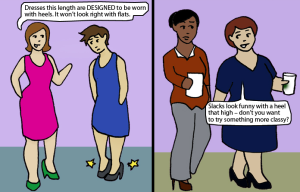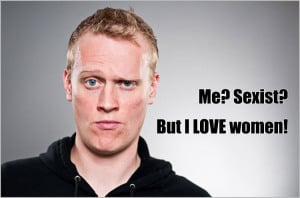
Person sitting on a bed in a dimly lit room.
This past summer, I was at my family home in the southern U.S. and, at one point, I was boxed into a conversation with my mother in the kitchen.
I was wearing a bindi, colorful short shorts, and a baggy black t-shirt. I also had hairy legs.
My mom hates my body hair, and that hatred is worsened when I’m wearing a cultural symbol like the bindi. It exposes my South Asian identity at the same time as it does my queerness.
During this conversation, she was intent on convincing me that “nobody in India looks like” me and that I’m representing not only our family but all of India when I walk outside the door into the public.
How I understand her comment is that her experience being an Indian immigrant to the U.S. has shaped her idea of acceptable presentation. And I was definitely not that.
It also made me realize that she hasn’t seen queer South Asians represented enough to know that they even exist.
As people of color who are also queer and/or trans, we have unique and varied experiences living at the intersections of those identities.
My experience being a person of the South Asian diaspora (someone with South Asian descent living outside of South Asia), the child of Indian immigrants, and non-binary makes it so that my transness isn’t strictly about gender — it’s much broader.
It’s about histories of colonialism and imperialism and my own process of decolonization because these factors directly shape the ways that I experience gender.
Gender dysphoria, according to Wikipedia, “is the distress a person experiences as a result of sex and gender they were assigned at birth.”
I would take that definition a step further. Though the medical assignment of sex and gender at birth is definitely a foundational part of it, a whole system that privileges cisgender performances, and polices everything that deviates from that is also attached.
Gender dysphoria isn’t talked about too much in the mainstream, but recent increases in the visibility of (mostly binary and cis-passing) trans people in the media have made it so that people are talking more about transness in general.
Folks seem to be speaking about transness at a pretty surface level, most projecting either acceptance or rejection onto trans people rather than considering the intricacies of trans peoples’ experiences.
Cultural dysphoria, as I see it, is the dissonance between the social expectations for an individual’s broad cultural performance or identity and their desired embodiment of that culture, or uncertainty about where they fit into cultural categories.
A bicultural friend of mine recently told me that she wants to connect with her Korean community but, because she doesn’t feel like she can speak the language or understand cultural practices, she feels like it’s hard to make it work.
This feeling is an example of cultural dysphoria.
Dysphoria is emotional.
Emotions are massively important to talk about now because we’re in a time when many people (not just conservatives) are quick to call folks sensitive rather than acknowledging that what we’re actually doing is continuing to confront our traumas, challenge injustice, and decolonize our lives.
I talk about how my mother wanted to restrict my physical presentation because of her understanding of gender and cultural rules. This social projection, or policing, is what produces dysphoria in the first place! Expectations are a part of what form and sustain gender and culture.
I want to talk to you about what produces this intersecting dysphoria for me — specifically, how my experiences with gender policing are intertwined with my culture, ethnicity, and, more broadly, processes of colonialism and imperialism.
1. Internal tension with whiteness played a role in producing my cultural dysphoria
Being a bicultural person has meant that, in my formative years, I was a South Asian always surrounded by white people. I struggled early on with maintaining a thriving social life at the same time as I was navigating my relationship with South Asian culture and my family.
I would often hear derogatory comments from my peers about aspects of my culture, like the smell of our food and stereotypes of South Asian accents.
So, because of this, I rejected my South Asian identity almost entirely and started to identify more with whiteness.
But, upon learning more about my identity in recent years and how I, as a South Asian, fit into the larger dynamic of race and culture in this country, I started to allow myself to let go of that comfort with whiteness.
What this meant was that…I had to be South Asian again!?
When I, as a bicultural person, thought more deeply about these things, I realized that I was pretty lost as to where I fit in.
Am I white? No. Am I a non-South Asian person of color? No, and I would be appropriating other people’s experiences to claim that.
Am I South Asian? As I mentioned, I don’t know much about South Asian culture because I’ve shut it out for a good deal of my life.
Needless to say, it got confusing, and I got confused. This is the essence of my cultural dysphoria.
2. South Asian American expectations about hair played a role in producing my gender dysphoria
When I started to realize how salient gender was to my experience (because of the way people gendered me), this added to my struggles with finding a comfortable cultural identity.
In the South Asian American community, my experience is that hair is one of the most prominent markers of gender, especially for femmes and women.
I remember hearing from one South Asian American cisgender woman that I appeared to be “basically a boy” when I had shoulder-length hair and was wearing gender neutral clothing. Additionally, I recall from high school that one of my white partners ironically proclaimed that they would never date an “Indian” because “Indians are too hairy — ew!”
There are a number of South Asian Americans who are dismantling the oppressive logic behind these gendered standards for hair that are also time-consuming, laborious, and expensive.
Yet, hair remains a pertinent topic and signal of (gender) deviance in our communities.
And so it is frequently policed when somebody performs outside of the expected norm.
3. The gender policing that I experience is inherently related to my South Asian diasporic identity
My hair is the most obvious sign of my gender and racial transgression, and so it’s been at the center of my experience with gender policing.
This policing included small comments or looks that would make me feel like I needed to remove or alter my hair — often to fit a Eurocentric feminine beauty ideal of, in my South Asian community — by being virtually hairless, maintaining perfect eyebrows, and having long, ‘manageable’ hair.
When I was twelve, I insisted on shaving my leg hair because I started to realize that my hair was way thicker and darker than my white friends’.
First, it was shaving my legs, which soon turned into shaving nearly my entire body.
I had been getting comments about my facial hair, and quickly understood (call it ‘family tradition’) that I should remove and lighten it with chemical bleach.
I was desperate to assume whiteness wherever and whenever I could to fit racialized standards for beauty that I felt expected to fit.
By ‘whiteness,’ I mean Eurocentric ideals that are built by white systems of thought, like fetishized mainstream images of South Asian feminine beauty — namely the idea that we’re desirable because we’re “exotic.”
Ideals like these are built from colonial logic that, as Rebecca Herzig discusses in her book Plucked: A History of Hair Removal, has pathologized “excess,” and dark hair growth, and has upheld whiteness as a standard for physical beauty and desirability.
These racialized barriers to identity formation were a central factor in how I came to understand my gender identity because they were my first introduction to the intersecting violence of racial and gender expectations.
4. My family’s expectations for appropriate gender presentation are intertwined with their immigrant identities
My parents taught me at an early age that assimilation into whiteness, or conforming to white culture and standards, is actually the path to success and happiness.
I later learned that this meant gender assimilation, conforming to acceptable (read: white, binary) gender, too. They often worry that my being ‘visibly queer,’ will cause me to face difficulties in the workplace and in my social life.
So, when they police my physical presentation, whether it be my exposed body hair, my shaved head, or my queered clothing, they’re often doing it because they have internalized ideas about what is respectable and acceptable in mainstream U.S. society.
I understand where they’re coming from in saying that deviance isn’t accepted in a lot of mainstream spaces — I actually totally agree. But, I don’t endorse the same respectability politics.
In other words, I’m not willing to ignore the anti-indigenous, anti-Black and Brown, trans-antagonistic, and colonial logic behind this expectation to blend into Eurocentric ideals.
This can almost definitely be explained by how I envision my possibilities as an American-born citizen, who has been afforded the resources to choose my life direction not only on the basis of what will give me the most financial mobility.
Nonetheless, the idea that I should present myself in socially acceptable ways for mobility and social process has contributed to the ways that I have experienced gender policing inside my family home and understood my possibilities for all types of resistance.
It has influenced how I live at the intersections of gender and culture, and how I experience both forms of dysphoria.
***
My path to embracing my transness has centered decolonization.
My family home and early childhood were two sites where I started to learn about what gender meant to me. As I’ve been able to access different spaces, I’ve grown to understand how destructive these Eurocentric norms are for self-acceptance.
Learning about histories of colonialism and oppression, alongside witnessing individuals who resist harmful norms that breed discomfort, has really helped me to understand who I am, apart from who I’ve been told I am.
This means looking at myself as not having to fit into one category of culture but accepting myself as a hybrid of many cultural influences.
I have adopted numerous practices — including filling the spaces I inhabit with affirmations, giving myself the liberty to maintain my body hair as I wish, and opening myself to learning about spirituality through the lens of multiple religions — to remind myself that, while my identity seems rare and massively underrepresented, I still need to remind myself of the validity of this ambiguous existence.
And while it’s empowering to fixate on the strength in this existence as resistance, it’s also important to acknowledge the massive emotional weight that comes with it.
When we live with these marginal identities, we often have very little affirmation and few frameworks for understanding how we can move beyond narrow ideas of what our lives can and should look like.
We live in a world that often values our labor over our personhood — our emotions, our comfort, our complexity (all things that matter!). So we need to learn about the microaggressions and internalized oppression that we might be overlooking for to comfort other people.
We must always remember that our existence is radical, and holds the potential for envisioning whole new futures of existence outside of narrow boxes.
[do_widget id=’text-101′]
Ayesha Sharma is a non-binary South Asian scholar and artist continually negotiating a relationship with themselves and their communities through practices of decolonization. They are most interested in literal and symbolic reclamation as an art practice and investing themselves in community care. Ayesha has written for the Urban Democracy Lab and is published in ANTYAJAA: Indian Journal of Women and Social Change.
Search our 3000+ articles!
Read our articles about:
Our online racial justice training
Used by hundreds of universities, non-profits, and businesses.
Click to learn more



















